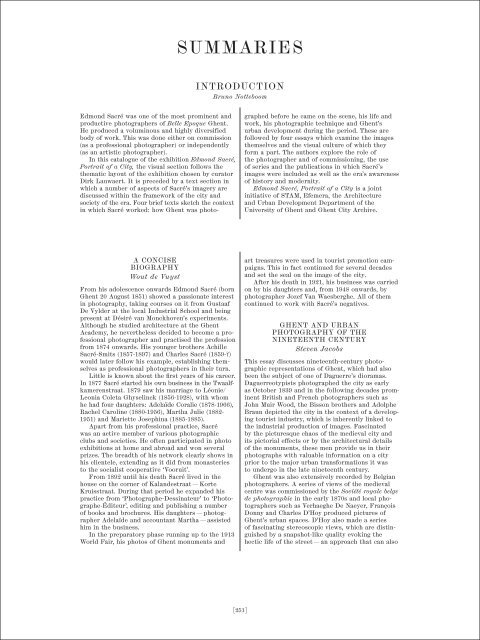Edmond Sacré Portret van een stad - Gent Cultuurstad vzw ...
Edmond Sacré Portret van een stad - Gent Cultuurstad vzw ...
Edmond Sacré Portret van een stad - Gent Cultuurstad vzw ...
You also want an ePaper? Increase the reach of your titles
YUMPU automatically turns print PDFs into web optimized ePapers that Google loves.
<strong>Edmond</strong> <strong>Sacré</strong> was one of the most prominent and<br />
productive photographers of Belle Epoque Ghent.<br />
He produced a voluminous and highly diversified<br />
body of work. This was done either on commission<br />
(as a professional photographer) or independently<br />
(as an artistic photographer).<br />
In this catalogue of the exhibition <strong>Edmond</strong> <strong>Sacré</strong>,<br />
Portrait of a City, the visual section follows the<br />
thematic layout of the exhibition chosen by curator<br />
Dirk Lauwaert. It is preceded by a text section in<br />
which a number of aspects of <strong>Sacré</strong>’s imagery are<br />
discussed within the framework of the city and<br />
society of the era. Four brief texts sketch the context<br />
in which <strong>Sacré</strong> worked: how Ghent was photo-<br />
A CONCISE<br />
BIOGRAPHY<br />
Wout de Vuyst<br />
From his adolescence onwards <strong>Edmond</strong> <strong>Sacré</strong> (born<br />
Ghent 20 August 1851) showed a passionate interest<br />
in photography, taking courses on it from Gustaaf<br />
De Vylder at the local Industrial School and being<br />
present at Désiré <strong>van</strong> Monckhoven’s experiments.<br />
Although he studied architecture at the Ghent<br />
Academy, he nevertheless decided to become a professional<br />
photographer and practised the profession<br />
from 1874 onwards. His younger brothers Achille<br />
<strong>Sacré</strong>-Smits (1857-1897) and Charles <strong>Sacré</strong> (1859-?)<br />
would later follow his example, establishing themselves<br />
as professional photographers in their turn.<br />
Little is known about the first years of his career.<br />
In 1877 <strong>Sacré</strong> started his own business in the Twaalfkamerenstraat.<br />
1879 saw his marriage to Léonie/<br />
Leonia Coleta Ghyselinck (1856-1928), with whom<br />
he had four daughters: Adelaïde Coralie (1878-1966),<br />
Rachel Caroline (1880-1956), Martha Julie (1882-<br />
1951) and Mariette Josephina (1885-1885).<br />
Apart from his professional practice, <strong>Sacré</strong><br />
was an active member of various photographic<br />
clubs and societies. He often participated in photo<br />
exhibitions at home and abroad and won several<br />
prizes. The breadth of his network clearly shows in<br />
his clientele, extending as it did from monasteries<br />
to the socialist cooperative ‘Vooruit’.<br />
From 1892 until his death <strong>Sacré</strong> lived in the<br />
house on the corner of Kalandestraat — Korte<br />
Kruisstraat. During that period he expanded his<br />
practice from ‘Photographe-Dessinateur’ to ‘Photographe-Éditeur’,<br />
editing and publishing a number<br />
of books and brochures. His daughters — photographer<br />
Adelaïde and accountant Martha — assisted<br />
him in the business.<br />
In the preparatory phase running up to the 1913<br />
World Fair, his photos of Ghent monuments and<br />
SUMMARIES<br />
INTRODUCTION<br />
Bruno Notteboom<br />
[251]<br />
graphed before he came on the scene, his life and<br />
work, his photographic technique and Ghent’s<br />
urban development during the period. These are<br />
followed by four essays which examine the images<br />
themselves and the visual culture of which they<br />
form a part. The authors explore the role of<br />
the photographer and of commissioning, the use<br />
of series and the publications in which <strong>Sacré</strong>’s<br />
images were included as well as the era’s awareness<br />
of history and modernity.<br />
<strong>Edmond</strong> <strong>Sacré</strong>, Portrait of a City is a joint<br />
initiative of STAM, Efemera, the Architecture<br />
and Urban Development Department of the<br />
University of Ghent and Ghent City Archive.<br />
art treasures were used in tourist promotion campaigns.<br />
This in fact continued for several decades<br />
and set the seal on the image of the city.<br />
After his death in 1921, his business was carried<br />
on by his daughters and, from 1948 onwards, by<br />
photographer Jozef Van Waesberghe. All of them<br />
continued to work with <strong>Sacré</strong>’s negatives.<br />
GHENT AND URBAN<br />
PHOTOGRAPHY OF THE<br />
NINETEENTH CENTURY<br />
Steven Jacobs<br />
This essay discusses ninet<strong>een</strong>th-century photographic<br />
representations of Ghent, which had also<br />
b<strong>een</strong> the subject of one of Daguerre’s dioramas.<br />
Daguerreotypists photographed the city as early<br />
as October 1839 and in the following decades prominent<br />
British and French photographers such as<br />
John Muir Wood, the Bisson brothers and Adolphe<br />
Braun depicted the city in the context of a developing<br />
tourist industry, which is inherently linked to<br />
the industrial production of images. Fascinated<br />
by the picturesque chaos of the medieval city and<br />
its pictorial effects or by the architectural details<br />
of the monuments, these men provide us in their<br />
photographs with valuable information on a city<br />
prior to the major urban transformations it was<br />
to undergo in the late ninet<strong>een</strong>th century.<br />
Ghent was also extensively recorded by Belgian<br />
photographers. A series of views of the medieval<br />
centre was commissioned by the Société royale belge<br />
de photographie in the early 1870s and local photographers<br />
such as Verhaeghe De Naeyer, François<br />
Donny and Charles D’Hoy produced pictures of<br />
Ghent’s urban spaces. D’Hoy also made a series<br />
of fascinating stereoscopic views, which are distinguished<br />
by a snapshot-like quality evoking the<br />
hectic life of the street — an approach that can also


